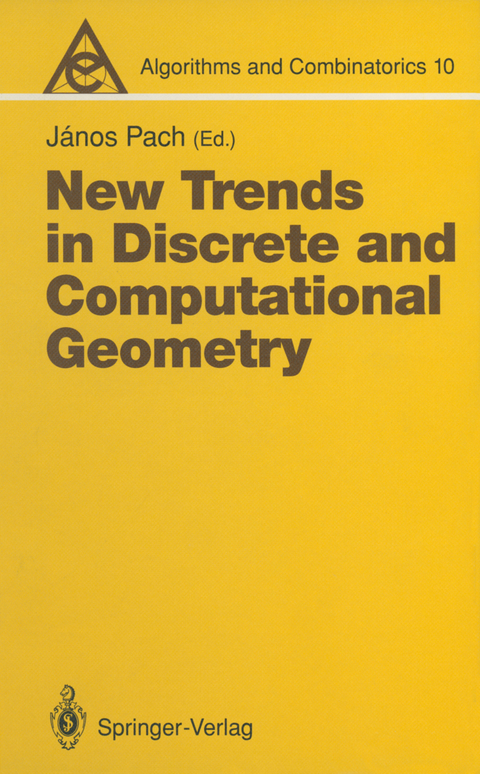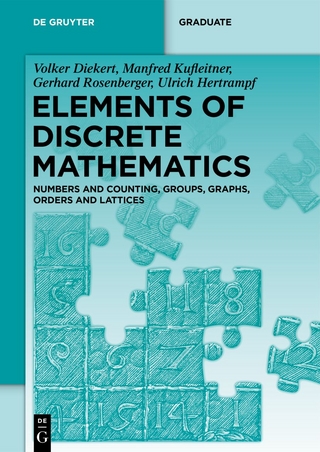
New Trends in Discrete and Computational Geometry
Springer Berlin (Verlag)
978-3-642-63449-9 (ISBN)
The most important new developments in discrete and computational geometry are summarized in this book. Special emphasis is put on those questions where the interaction between the two disciplines is the strongest. Concise and clear in style, this book introduces the most efficient combinatorial, probabilistic and topological methods that can be used to design effective geometric algorithms for motion planning, robotics, scene analysis, computer-aided design, etc. Most of the methods and results discussed in the book have not appeared in any previously published monograph. In particular, this book contains the first systematic treatment of epsilon-nets, geometric transversal theory, partitions of Euclidean spaces and a general method for the analysis of randomized geometric algorithms. The chapters are self-con- tained surveys written by leading experts in the field. The book will be used by researchers, graduate students, and engineers interested in applications.
I. Combinatorics and Algorithms of Arrangements.- 1. Introduction.- 2. Arrangements of Curves in the Plane.- 3. Lower Envelopes and Davenport-Schinzel Sequences.- 4. Faces in Arrangements.- 5. Arrangements in Higher Dimensions.- 6. Summary.- References.- II. Backwards Analysis of Randomized Geometric Algorithms.- 1. Introduction.- 2. Delaunay Triangulations of Convex Polygons.- 3. Intersecting Line Segments.- 4. Constructing Planar Convex Hulls.- 5. Backwards Analysis of QUICKSORT.- 6. A Bad Example.- 7. Linear Programming for Small Dimension.- 8. Welzl's Minidisk Algorithm.- 9. Clarkson's Backwards Analysis of the Conflict Graph Based on the Convex Hull Algorithm.- 10. Odds and Ends.- References.- III. Epsilon-Nets and Computational Geometry.- 1. Range Spaces and ?-Nets.- 2. Geometric Range Spaces.- 3. A Sample of Applications.- 4. Removing Logarithms.- 5. Removing the Randomization.- References.- IV. Complexity of Polytope Volume Computation.- 1. Jumps of the Derivatives.- 2. Exact Volume Computation is Hard.- 3. Volume Approximation.- References.- V. Allowable Sequences and Order Types in Discrete and Computational Geometry.- 1. Introduction.- 2. Combinatorial Types of Configurations in the Plane and Allowable Sequences.- 3. Arrangements of Lines and Pseudolines.- 4. Applications of Allowable Sequences.- 5. Order Types of Points in Rd and "Geometric Sorting".- 6. The Number of Order Types in Rd.- 7. Isotopy and Realizability Questions.- 8. Lattice Realization of Order Types and the Problem of Robustness in Computational Geometry.- References.- VI. Hyperplane Approximation and Related Topics.- 1. Introduction.- 2. MINSUM Problem: Orthogonal L1-Fit.- 3. MINSUM Problem: Vertical L1-Fit.- 4. MINMAX Problem: Orthogonal L?-Fit.- 5. MINMAX Problem: VerticalL?-Fit.- 6. Related Issues.- References.- VII. Geometric Transversal Theory.- 1. Introduction.- 2. Hadwiger-Type Theorems.- 3. The Combinatorial Complexity of the Space of Transversals.- 4. Translates of a Convex Set.- 5. Transversal Algorithms.- 6. Other Directions.- References.- VIII. Hadwiger-Levi's Covering Problem Revisited.- 0. Introduction.- 1. On I0(K) and I?(K).- 2. On Il(K) and k-fold Illumination.- 3. Some Simple Remarks on H(B).- 4. On Convex Bodies with Finitely Many Corner Points.- 5. Solution of Hadwiger-Levi's Covering Problem for Convex Polyhedra with Affine Symmetry.- References.- IX. Geometric and Combinatorial Applications of Borsuk's Theorem.- 1. Introduction.- 2. Van Kampen-Flores Type Results.- 3. The Ham-Sandwich Theorem.- 4. Centrally Symmetric Polytopes.- 5. Kneser's Conjecture.- 6. Sphere Coverings.- References.- X. Recent Results in the Theory of Packing and Covering.- 1. Introduction.- 2. Preliminaries and Basic Concepts.- 3. A Review of Some Classical Results in the Plane.- 4. Economical Packing in and Covering of the Plane.- 5. Multiple Packing and Covering.- 6. Some Computational Aspects of Packing and Covering.- 7. Restrictions on the Number of Neighbors in a Packing.- 8. Selected Topics in 3 Dimensions.- References.- XI. Recent Developments in Combinatorial Geometry.- 1. The Distribution of Distances.- 2. Graph Dimensions.- 3. Geometric Graphs.- 4. Arrangements of Lines in Space.- References.- XII. Set Theoretic Constructions in Euclidean Spaces.- 0. Introduction.- 1. Simple Transfinite Constructions.- 2. Closed Sets or Better Well-Orderings.- 3. Extending the Coloring More Carefully.- 4. The Use of the Continuum Hypothesis.- 5. The Infinite Dimensional Case.- 6. Large Paradoxical Sets in Another Sense.- References.- AuthorIndex.
| Erscheint lt. Verlag | 3.10.2013 |
|---|---|
| Reihe/Serie | Algorithms and Combinatorics |
| Zusatzinfo | XI, 340 p. 9 illus. |
| Verlagsort | Berlin |
| Sprache | englisch |
| Maße | 155 x 235 mm |
| Gewicht | 539 g |
| Themenwelt | Mathematik / Informatik ► Mathematik ► Graphentheorie |
| Schlagworte | Algorithmentheorie • Approximation von Hyperebenen • Combinatorial Geometry • combinatorics • Computational Geometry • Convexity • Discrete Geometry • Diskrete Geometrie • epsilon-nets • Epsilonnetze • hyperplane approximations • Kombinatorik • Konvexität • Mathematics • Partition • robot • Robotics • Theory of Algorithms |
| ISBN-10 | 3-642-63449-4 / 3642634494 |
| ISBN-13 | 978-3-642-63449-9 / 9783642634499 |
| Zustand | Neuware |
| Haben Sie eine Frage zum Produkt? |
aus dem Bereich
